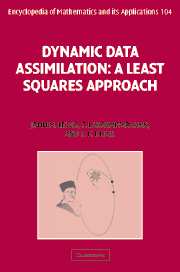Book contents
- Frontmatter
- Contents
- Preface
- Acknowledgements
- PART 1 GENESIS OF DATA ASSIMILATION
- PART II DATA ASSIMILATION: DETERMINISTIC/STATIC MODELS
- PART III COMPUTATIONAL TECHNIQUES
- PART IV STATISTICAL ESTIMATION
- PART V DATA ASSIMILATION: STOCHASTIC/STATIC MODELS
- PART VI DATA ASSIMILATION: DETERMINISTIC/DYNAMIC MODELS
- PART VII DATA ASSIMILATION: STOCHASTIC/DYNAMIC MODELS
- 27 Linear filtering – part I: Kalman filter
- 28 Linear filtering: part II
- 29 Nonlinear filtering
- 30 Reduced-rank filters
- PART VIII PREDICTABILITY
- Epilogue
- References
- Index
29 - Nonlinear filtering
from PART VII - DATA ASSIMILATION: STOCHASTIC/DYNAMIC MODELS
Published online by Cambridge University Press: 18 December 2009
- Frontmatter
- Contents
- Preface
- Acknowledgements
- PART 1 GENESIS OF DATA ASSIMILATION
- PART II DATA ASSIMILATION: DETERMINISTIC/STATIC MODELS
- PART III COMPUTATIONAL TECHNIQUES
- PART IV STATISTICAL ESTIMATION
- PART V DATA ASSIMILATION: STOCHASTIC/STATIC MODELS
- PART VI DATA ASSIMILATION: DETERMINISTIC/DYNAMIC MODELS
- PART VII DATA ASSIMILATION: STOCHASTIC/DYNAMIC MODELS
- 27 Linear filtering – part I: Kalman filter
- 28 Linear filtering: part II
- 29 Nonlinear filtering
- 30 Reduced-rank filters
- PART VIII PREDICTABILITY
- Epilogue
- References
- Index
Summary
This chapter provides an overview of the methods for recursively estimating the state of a nonlinear stochastic dynamical system based on a set of observations that (a) depend (nonlinearly) on the state being estimated and (b) are corrupted by additive white noise. The exact solution to this problem involves characterizing the evolution of the posterior probability density function over the state space, ℝn. This evolution equation can easily be derived from first principles. However, except in special cases (linear dynamics and linear observations) it is often difficult to explicitly characterize the form of the density as a function of space and time. Numerical methods are the only recourse to solving this class of infinite dimensional problems. Given this challenge and the difficulty, researchers have sought for alternate characterization, namely to compute the evolution of the moments of distribution of states being estimated. Ideally, one would require infinitely many moments to provide an equivalent characterization of the distribution. This infinite dimensional problem is further exacerbated by the fact that the rth moment often depends on the qth moment, for q > r. Computational feasibility demands that we find a “good” finite dimensional approximation to this infinite system of coupled moments.
One useful idea is to find the closure property among these moments, namely to find the least positive integer p such that the first p moments depend only among themselves and not on moments of order larger than p.
- Type
- Chapter
- Information
- Dynamic Data AssimilationA Least Squares Approach, pp. 509 - 533Publisher: Cambridge University PressPrint publication year: 2006



